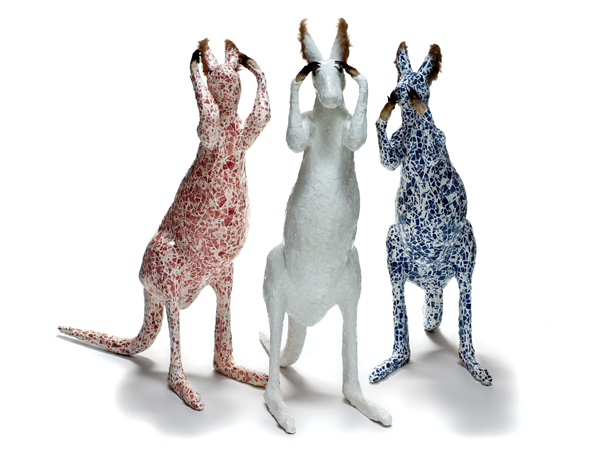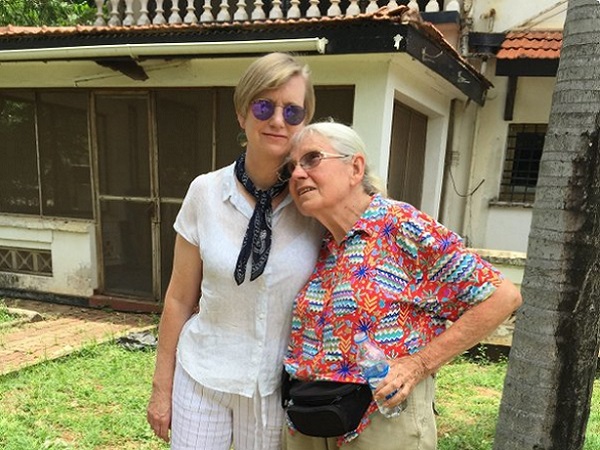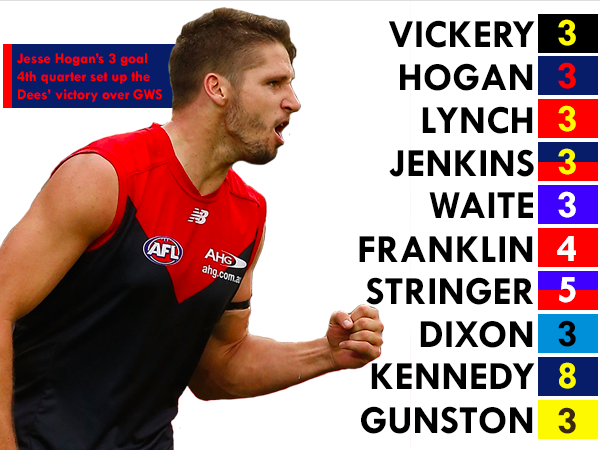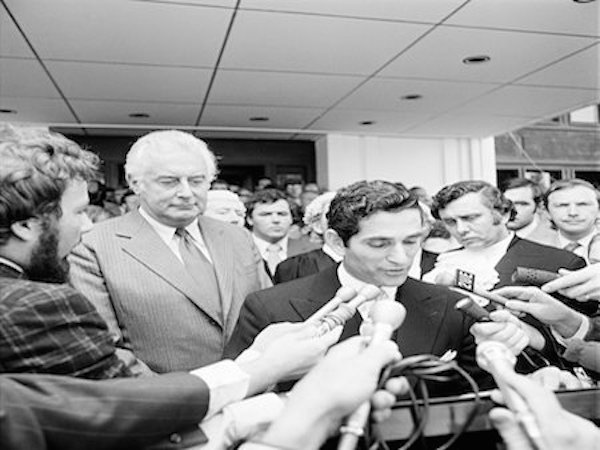There is no one word in any Aboriginal language for ‘art’.
Art forms are viewed as an integral part of life and the celebration of life, according to Penny Tripcony, Manager of the Oodgeroo Unit at the Queensland University of Technology
This explains what makes Menagerie, an acclaimed exhibition of Indigenous sculpture, so special. It incorporates the traditional life, culture and spirituality of Aboriginal Australians. It is not just art for art’s sake.
The sculptures of animals in the exhibition are artistically conceptualised and constructed. There are 33 works representing an amazing collection of native animals by award-winning Aboriginal and Torres Strait Islander artists. The works use a diverse mix of materials ranging from fibre, wood, rusty metals, ceramic, and taxidermy.
There is Danie Mellor’s three life-sized kangaroos striking the ‘hear no evil, speak no evil, see no evil’ pose; Vicki West’s cuddly-looking Tasmanian devil has its head slightly lowered as if overwhelmed by its facial tumour; Laurie Nielsen’s magnificent barbed wired emu that looks trapped and irate. The animals’ postures and the marked expressions on some of their faces seem to be recounting a host of different stories and experiences ranging from tragedy to comedy, satirical or political.
[oqeygallery id=70]
Images supplied
According to curator Nicole Foreshew, “The representations of animals signify a collective voice through which these artists share in the importance of making known the connections between people, place and country.
“In these sculptures, the artists are also transcribing cultural knowledge and kinship along with the external factors that influence the lives of these animals and the conditions in which we all survive,” she says.
The artists’ choices of material illustrate what was obtainable from their various environs, whether they found their media in their immediate surroundings, or sourced and collected it from natural or other environments.
Indigenous artist Danie Mellor, of the Mamu/Ngagen/Ngagan people in Mackay, comes to his work with a unique mix of cultural heritage that has helped shape his design style. His father was partly American and Australian, and his mother partly Irish and Indigenous Australian. His sculptures represent native animals in a fusion of eclectic contemporary materials.
“My heritage informs a core aspect of my work, in that there is an engagement with ideas about history, and the impact that processes of colonisation had on people and culture, and also the environment,” he says.
His life-sized kangaroos, ‘Red, White and Blue’, lined up in a row, are overlaid with fragmented ceramic with real paws and ears obtained from a taxidermist.
According to co-curator Brenda L. Croft, “Danie Mellor’s designs are based on traditional carvings from his community in the Torres Strait, but he has made them very definitively his, even though they are representing communal stories that are not owned by him but owned by his particular language group.”
Danie says the stories behind his work reflect his interest in history. “How to speak about Indigenous and non-Indigenous perspectives has been an important focus in my practice, and describing in pictorial form the devastating impact of changing environments on Aboriginal culture is a core element of my work.
“I am influenced by stories of people’s experiences. Incorporating oral histories and written or visual depictions of events and places is something I find to be a continually rich source of inspiration.”
The extraordinary Tasmanian devil ‘Hella’, by Indigenous artist Vicki West, is made from sea kelp roughly stitched together as if to hold the limbs and the body from falling apart. The artist sees this as a metaphor for the crisis of survival facing the species as result of the fatal facial tumour afflicting them.
Ms Croft says, “Sea kelp was used to make traditional water carriers in Tasmanian Aboriginal communities. Vicky has used this material as being closely associated with Aboriginal visual culture in Tasmania, in a way that is quite contemporary.
“The Tasmanian devil has a cutesy feel because of its small size, but it’s also got a very strong environmental message, which is also a metaphor for what Aboriginal people in Tasmania had to put up with: being told that they no longer exist.”
Laurie Nilsen says his life-size emu, wrought from barbed wire, steel and aluminium, expresses his message of the environmental issue that plagues this animal whose profile is part of the Australian Coat of Arms. The artist has seen so many emus die, trapped on barbed wires that block their passage as they travel across their natural landscape, because they can’t get to water.
“Barbed wires not only fenced off animals,” Ms Croft points out, “but also Aboriginal people who were kept from the traditional paths they used to tread.” Laurie Nilsen says he makes his emus out of barbed wire, the thing that kills them, “so it’s almost like … reincarnating them again. But I don’t think I’ll ever get around to making as many as I’ve seen perish”.
Animals form a core part of Aboriginal culture and spirituality. Most of the animal sculptures in Menagerie are a representation of the artists’ totems. For instance, the emu is a traditional totem for Laurie Nilsen; the native bee, called ‘stingless’ or ‘sugar bag’ is the traditional totem for Brenda L. Croft.
However, Danie Mellor presents the kangaroo, a distinctive Indigenous animal, as a national totem of Australia. “It could be said that the kangaroo is so unique to Australia, it’s almost a universal totem, and highly symbolic if being Australian,” he says.
As Ms Croft says, all natural life as well as inanimate objects play a huge role in Aboriginal and Torres Strait Islander culture. “The trees, rocks, water holes, everything has a place, and you don’t operate within that structure by your own philosophy. You’re a part of something, not separate from things,” she says.
“Animals are manifestations and representations of ancestral and living beings. If a particular animal is your totem, you’re responsible for it. You’re not allowed to kill or eat it because that would be killing you.”
According to Nicole Foreshew, despite changing land management practices, the clearing of habitats and the introduction of foreign species, animals remain a great teacher.
“They are witness to seasonal change. They migrate from place to place, and participate in cycles that contribute to the maintenance and renewal of habitats. Animals also act as indicators of change through their movements, their sounds, and their traces.
“They explain cycles of events with the earth’s atmosphere: fresh water, salt water, desert, rain forest, rocky and stony peaks, wet and dry lands. This information is transmitted in the works presented in Menagerie. The artists are presenting themselves as informants, reminding us of an animal existence, and their access to, and continued relationship with these animals.”
Like any good art from any artists in any country, there is a real depth to what Indigenous people of any country bring to their work – they bring generations of traditions, Ms Croft says.
“I think what people respond to in good Indigenous art is the heartbeat of the artist. You can see it, whether it’s whimsy or humour, satire or political; the work has meaning, it’s not just art for the sake of art.”
Menagerie was launched in Sydney through the collaborative effort of Object: Australian Centre for Craft and Design and the Australian Museum and is scheduled to run until March, 2014. However, Brenda Croft says, it is one chapter in an ongoing story that has no beginning, middle or end.
Catherine Bassey is a Post graduate Journalism student at the University of Technology Sydney. You can read more about her works at her blog and follow her on Twitter @bcathee.







